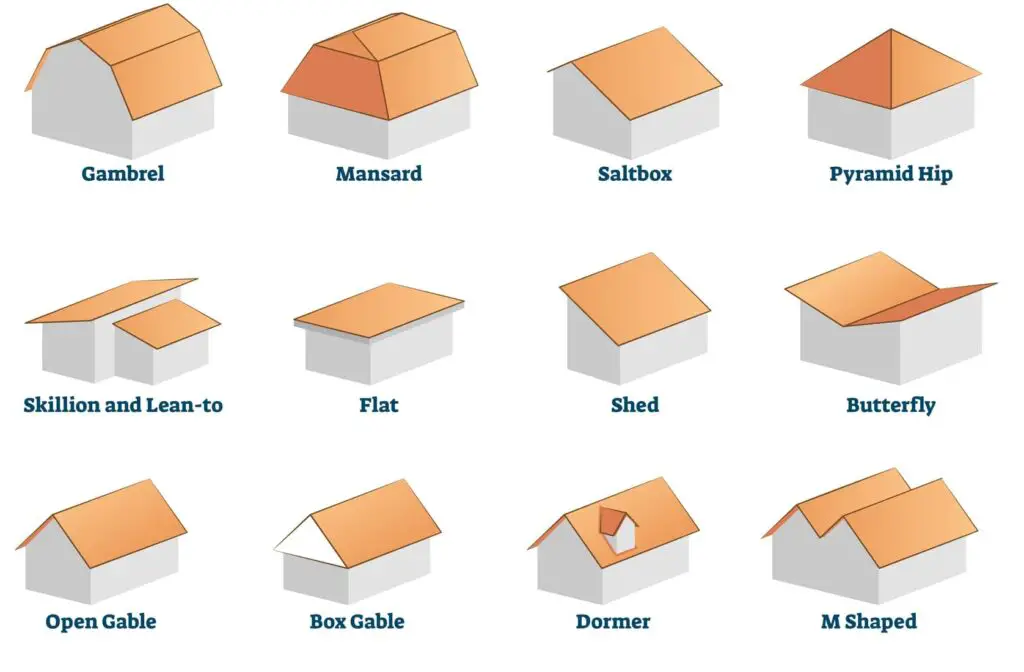Roofs are not just about providing shelter; they play a crucial role in the aesthetics, energy efficiency, and overall value of a home. Choosing the right type of roof is a significant decision that involves considering various factors, including climate, architectural style, and budget. This comprehensive guide delves into the top 10 types of roofs, highlighting their characteristics, advantages, and disadvantages, helping you make an informed decision.
1. Gable Roof
Overview
The gable roof, also known as a pitched or peaked roof, is one of the most popular and easily recognizable roof styles. It features two sloping sides that meet at the top, forming a ridge.
Advantages
- Simple Design: Easy to construct and requires fewer materials, making it cost-effective.
- Excellent Drainage: The steep pitch allows for efficient water and snow runoff.
- Versatility: Suitable for various climates and architectural styles.
Disadvantages
- Wind Susceptibility: In areas prone to high winds, gable roofs can be more vulnerable to damage.
2. Hip Roof
Overview
A hip roof has slopes on all four sides, which are of equal length and converge at the top to form a ridge. This design is more complex than a gable roof.
Advantages
- Stability: The inward slope on all sides makes it more stable and resistant to wind.
- Durability: Better suited for areas with high winds and heavy snowfall.
Disadvantages
- Complex Construction: More materials and labor-intensive, leading to higher costs.
- Less Ventilation: The design can limit ventilation options in the attic space.
3. Flat Roof
Overview
Flat roofs are horizontal or nearly horizontal, with a slight pitch to allow for water drainage. Commonly found in commercial buildings and modern homes.
Advantages
- Easy Construction: Simple design makes it easy to construct and maintain.
- Usable Space: Can be used for additional living space, such as a rooftop garden or patio.
Disadvantages
- Drainage Issues: Poor drainage can lead to water pooling and leaks.
- Shorter Lifespan: Generally, they have a shorter lifespan compared to pitched roofs.
4. Mansard Roof
Overview
The mansard roof, also known as a French roof, has four sides with a double slope on each side. The lower slope is steeper than the upper one.
Advantages
- Additional Space: Creates extra living or storage space in the attic area.
- Aesthetic Appeal: Adds a distinctive, elegant look to a building.
Disadvantages
- Complex Design: Complicated structure requires more materials and skilled labor.
- Cost: Generally more expensive to build and maintain.
5. Gambrel Roof
Overview
Commonly seen in barns, the gambrel roof has two different slopes on each side. The lower slope is steeper than the upper slope, providing a barn-like appearance.
Advantages
- Efficient Space Use: Offers more attic or storage space due to its design.
- Classic Aesthetic: Provides a traditional, rustic look.
Disadvantages
- Maintenance: Requires regular maintenance, especially in harsh climates.
- Wind Resistance: Not as wind-resistant as other roof types.
6. Butterfly Roof
Overview
A modern and unique design, the butterfly roof has two inward-sloping sides that meet in the middle, resembling a butterfly’s wings.
Advantages
- Water Collection: Ideal for rainwater harvesting due to its inward slope.
- Modern Aesthetics: Adds a contemporary look to homes.
Disadvantages
- Complex Drainage: Requires a well-designed drainage system to prevent water issues.
- Higher Cost: More expensive to design and construct.
7. Skillion Roof
Overview
Also known as a shed roof, the skillion roof is a single, sloping roof surface, often used for home extensions or modern architecture.
Advantages
- Simple Construction: Easy to build with fewer materials.
- Modern Look: Provides a sleek, contemporary appearance.
Disadvantages
- Limited Attic Space: The single slope limits the amount of attic or storage space.
- Wind Susceptibility: Can be vulnerable to high winds depending on the slope.
8. Jerkinhead Roof
Overview
A jerkinhead roof combines elements of both gable and hip roofs. The gable ends are clipped, creating a more compact and stable structure.
Advantages
- Wind Resistance: More wind-resistant than a standard gable roof.
- Aesthetic Appeal: Offers a unique and attractive look.
Disadvantages
- Complexity: More complex design can increase construction costs.
- Ventilation Challenges: Limited ventilation options in the attic.
9. Bonnet Roof
Overview
Similar to a hip roof but with an extended lower slope, the bonnet roof provides extra covered space around the building.
Advantages
- Covered Porch: The extended slope offers natural shade and protection for outdoor areas.
- Stability: Highly stable and wind-resistant.
Disadvantages
- Higher Costs: More materials and labor increase overall costs.
- Maintenance: Extended eaves can require additional maintenance.
10. Sawtooth Roof
Overview
The sawtooth roof features multiple parallel pitches with vertical surfaces, resembling the teeth of a saw. Often used in industrial buildings.
Advantages
- Natural Light: Vertical surfaces can include windows, allowing for ample natural light.
- Modern Industrial Look: Provides a distinctive, industrial appearance.
Disadvantages
- Complexity: Complicated design requires skilled labor and increased materials.
- Water Drainage: Requires a well-planned drainage system to prevent leaks.
Conclusion
Choosing the right roof for your home or building is a decision that should balance aesthetics, functionality, and budget. Each roof type offers unique benefits and challenges, making it crucial to consider your specific needs and the environmental conditions in your area. Whether you prefer the classic appeal of a gable roof, the modern aesthetics of a butterfly roof, or the practicality of a flat roof, understanding the characteristics of each type will guide you in making an informed and satisfying choice.


